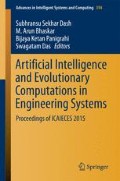Abstract
Security deployment in data communication is very vital, where authentication is most obvious prerequisite. However, similar authentication procedures are not appropriate in hierarchical mobile ad hoc networks as it is characterized by infrastructure less. We develop and evaluate security method based on multilevel key distribution, called cluster-based distributed key architecture for MANETs, which addresses two important characteristics: authentication and authorization. It considers cluster head selection based on novel metric called “optimized packet processing capacity” and multilevel key distribution process with the help of diffie-Hellman Key distribution. We evaluated the availability of the security infrastructure, and its overhead using NS2. Results show that it is possible to deploy security architecture with an acceptable performance and overhead.
Access this chapter
Tax calculation will be finalised at checkout
Purchases are for personal use only
References
Rafaeli S, Hutchison D. A survey of key management for secure group communication. ACM computing surveys; 2003. p. 309–29.
Kim Y, Perrig A, Tsudik G. Simple and fault-tolerant keyagreement for dynamic collaborative groups. In: Proceedings of the ACM conference on computer and communications security; 2000. p. 235–44.
Ateniese G, Steiner M, Tsudik G, Authenticated group key agreement and friends. In: Proceedings of the 5th ACM conference on computer and communications security, New York, NY, USA, San Francisco, California, United States: ACM Press; 1998. p. 17–26.
Burmester M, Desmedt Y. Efficient and secure conference key distribution. In: Proceedings of the security protocols. Workshop, Cambridge, UK: Springer-Verlag; 1996. pp. 119–129. Taormina: Communications (ISCC); 2002.
Blundo C, Santis AD, Herzberg A, Kutten S, Vaccaro U, Yung M. Perfectly-secure key distribution for dynamic conferences. Inf Comput. 1998;146(1):1–23.
Fiat A, Naor M. Broadcast encryption. In: CRYPTO’93, Lecture notes in computer science, vol. 773. New York, Inc., Santa Barbara, California, United States: Springer-Verlag; 1994. p. 480–91.
Basagni S, Herrin K, Bruschi D, Rosti E. Secure pebblenets. In: Proceedings of the 2nd ACM international symposiumon Mobile ad hoc networking and computing, New York, NY, USA: ACMPress; 2001. p. 156–63.
Mohammad AAK, Mirza A, Razzak MA. Reactive energy aware routing selection based on Knapsac. Emergency ICT for bridging the future, vol. 2. Switzerland: Springer International Publishing; 2015.
Chiang CC et al. Routing in cluster Multi hop ad hoc networks with fading channel. In: Proceeding of IEEE SICON; 1997. p. 197–211.
Murthy1 NVES, Naresh VS. Extended diffie-hellman technique to generate multiple shared keys at a time with reduced keos and its polynomial time complexity. IJCSI Int J Comput Sci Issues. May 2010;7(Issue 3, No. 3).
Bresson E, Chevassut O, Pointcheval D. Dynamic group diffie-Hellman Key exchange under standard assumption. In: IACR; 2002. p. 321–36.
Martello S, Toth P. Knapsack problems, catalog.enu.kz, 1990.
Author information
Authors and Affiliations
Corresponding author
Editor information
Editors and Affiliations
Rights and permissions
Copyright information
© 2016 Springer India
About this paper
Cite this paper
Rajanna, B., Rajeswara Rao, R. (2016). Cluster-Based Distributed Key Architecture Scheme for MANETs. In: Dash, S., Bhaskar, M., Panigrahi, B., Das, S. (eds) Artificial Intelligence and Evolutionary Computations in Engineering Systems. Advances in Intelligent Systems and Computing, vol 394. Springer, New Delhi. https://doi.org/10.1007/978-81-322-2656-7_26
Download citation
DOI: https://doi.org/10.1007/978-81-322-2656-7_26
Published:
Publisher Name: Springer, New Delhi
Print ISBN: 978-81-322-2654-3
Online ISBN: 978-81-322-2656-7
eBook Packages: EngineeringEngineering (R0)

